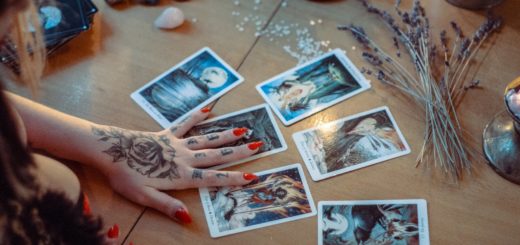How to Start Reading Tarot Cards for Self-Discovery

Before diving in, please note: This post is for informational purposes only. If you’d like to know more about how we approach topics, feel free to check out our friendly Disclaimer Page.
Hey there, amazing readers! 🖐️ Just a quick note: yes, we know there are a lot of ads here. Trust us, we get it—it’s not the prettiest look, but they help us keep this blog alive and kicking. Those pesky little ads cover the costs of all the behind-the-scenes magic, from hosting and tech stuff to creating content we hope you’ll love.
We’re committed to delivering quality posts, and your support (even just sticking around despite the ads) means everything to us. So, bear with us, and thanks for helping us keep the good vibes rolling. Now, on to the fun stuff! 😉
TRANSLATE BUTTON AT THE END OF THE ARTICLE
Tarot cards have long been used as a tool for insight, reflection, and self-discovery.
Whether you’re curious about tarot for personal growth or seeking a deeper understanding of yourself, starting with tarot can be both exciting and enlightening.
This article will guide you through the basics of tarot reading, offering practical steps and tips to help you embark on your journey of self-discovery with tarot cards.
Introduction
Tarot cards are a powerful tool for exploring your inner world and gaining clarity on various aspects of your life.
By delving into the symbolism and meanings of the cards, you can uncover hidden insights, reflect on personal challenges, and gain a better understanding of your life’s path.
In this guide, we’ll cover everything you need to get started with tarot, from selecting a deck to performing your first reading.
Understanding Tarot Cards
Before you begin reading tarot cards, it’s essential to understand their structure and purpose.
A standard tarot deck consists of 78 cards, divided into two main sections: the Major Arcana and the Minor Arcana.
Major Arcana
The Major Arcana consists of 22 cards that represent significant life events, spiritual lessons, and major themes.
Each card has its own unique symbolism and message, often reflecting deeper aspects of personal growth and transformation.
Minor Arcana
The Minor Arcana is made up of 56 cards divided into four suits: Cups, Swords, Wands, and Pentacles.
Each suit corresponds to different areas of life, such as emotions, intellect, creativity, and material concerns.
The Minor Arcana cards provide more detailed insights into everyday situations and challenges.
Choosing Your Tarot Deck
Selecting a tarot deck that resonates with you is an important first step.
There are countless decks available, each with its own artwork, symbolism, and theme.
Here are a few tips for choosing a deck:
Consider the Artwork
Choose a deck with artwork that appeals to you personally.
The images on the cards should resonate with your intuition and make it easier for you to connect with the meanings of the cards.
Research Decks
Take some time to research different tarot decks and their interpretations.
Look for decks that align with your interests and goals for tarot reading.
Start with a Traditional Deck
If you’re new to tarot, starting with a traditional deck like the Rider-Waite-Smith can be helpful.
This deck is widely used and comes with a wealth of resources and interpretations that can aid in your learning process.
Learning the Basics of Tarot Reading
Once you’ve chosen your deck, it’s time to start learning the basics of tarot reading.
Here are some key steps to help you get started:
1. Familiarize Yourself with the Cards
Spend time studying each card and its meanings.
Look at the imagery, symbols, and associated keywords.
Many tarot decks come with guidebooks that provide detailed descriptions of each card.
2. Practice Card Spreads
A card spread is a layout of cards used to address specific questions or themes.
Start with simple spreads like the three-card spread, which can represent past, present, and future or situation, action, and outcome.
As you become more comfortable, you can explore more complex spreads.
3. Trust Your Intuition
While learning the traditional meanings of the cards is important, trust your intuition during readings.
Allow yourself to interpret the cards based on your personal insights and feelings.
Intuition plays a significant role in tarot reading and can enhance your self-discovery process.
4. Keep a Tarot Journal
Maintaining a tarot journal is a valuable practice for tracking your progress and insights.
Record your readings, interpretations, and reflections.
This journal can help you see patterns, track your growth, and gain deeper insights into your own journey.
Performing Your First Tarot Reading
Now that you’re familiar with the basics, it’s time to perform your first tarot reading.
Here are some steps to guide you through the process:
1. Set Your Intention
Before starting your reading, take a moment to set a clear intention or focus for the session.
This could be a specific question, a general theme, or an area of your life you want to explore.
2. Shuffle the Cards
Shuffle the cards while concentrating on your intention or question.
This helps to infuse your energy into the deck and align the cards with your focus.
3. Draw and Lay Out the Cards
Draw the cards from the deck and lay them out according to your chosen spread.
Take your time to observe the images and notice any initial impressions or feelings.
4. Interpret the Cards
Begin interpreting the cards based on their traditional meanings, as well as your intuitive insights.
Consider how the cards relate to each other and the overall message they convey.
5. Reflect and Conclude
Take a moment to reflect on the reading and any insights you’ve gained.
Consider how the messages from the cards can apply to your life and how you can use this information for self-discovery and growth.
Tips for Successful Tarot Reading
Practice Regularly: The more you practice, the more confident and intuitive you’ll become.
Set aside regular time for tarot readings to deepen your understanding and skills.
Stay Open-Minded: Approach each reading with an open mind and a willingness to explore new perspectives.
Avoid jumping to conclusions and be receptive to the messages the cards offer.
Seek Guidance: If you’re unsure about your interpretations, seek guidance from experienced tarot readers or resources.
Joining tarot communities or taking workshops can provide valuable support and insights.
Conclusion
Reading tarot cards for self-discovery can be a rewarding and transformative experience.
By understanding the structure of the deck, choosing a deck that resonates with you, and practicing regularly, you can unlock new levels of insight and personal growth.
Remember to trust your intuition, keep a journal, and approach each reading with an open heart.
As you continue your journey with tarot, you’ll discover valuable insights and deepen your connection with yourself.

The Enlightenment Journey is a remarkable collection of writings authored by a distinguished group of experts in the fields of spirituality, new age, and esoteric knowledge.
This anthology features a diverse assembly of well-experienced authors who bring their profound insights and credible perspectives to the forefront.
Each contributor possesses a wealth of knowledge and wisdom, making them authorities in their respective domains.
Together, they offer readers a transformative journey into the realms of spiritual growth, self-discovery, and esoteric enlightenment.
The Enlightenment Journey is a testament to the collective expertise of these luminaries, providing readers with a rich tapestry of ideas and information to illuminate their spiritual path.
Our Diverse Expertise 🌟
While our primary focus is on spirituality and esotericism, we are equally passionate about exploring a wide range of other topics and niches 🌍📚. Our experienced team is dedicated to delivering high-quality, informative content across various subjects ✨.
To ensure we provide the most accurate and valuable insights, we collaborate with trusted experts in their respective domains 🧑🏫👩🏫. This allows us to offer well-rounded perspectives and knowledge to our readers.
Our blog originally focused on spirituality and metaphysics, but we’ve since expanded to cover a wide range of niches. Don’t worry—we continue to publish a lot of articles on spirituality! Frequently visit our blog to explore our diverse content and stay tuned for more insightful reads.





